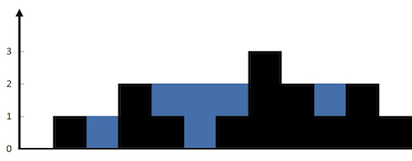[LeetCode] Trapping Rain Water 收集雨水
Given n non-negative integers representing an elevation map where the width of each bar is 1, compute how much water it is able to trap after raining.

The above elevation map is represented by array [0,1,0,2,1,0,1,3,2,1,2,1]. In this case, 6 units of rain water (blue section) are being trapped. Thanks Marcos for contributing this image!
Example:
Input: [0,1,0,2,1,0,1,3,2,1,2,1]
Output: 6
这道收集雨水的题跟之前的那道 Largest Rectangle in Histogram 有些类似,但是又不太一样,先来看一种方法,这种方法是基于动态规划 Dynamic Programming 的,维护一个一维的 dp 数组,这个 DP 算法需要遍历两遍数组,第一遍在 dp[i] 中存入i位置左边的最大值,然后开始第二遍遍历数组,第二次遍历时找右边最大值,然后和左边最大值比较取其中的较小值,然后跟当前值 A[i] 相比,如果大于当前值,则将差值存入结果,参见代码如下:
C++ 解法一:
class Solution {
public:
int trap(vector<int>& height) {
int res = , mx = , n = height.size();
vector<int> dp(n, );
for (int i = ; i < n; ++i) {
dp[i] = mx;
mx = max(mx, height[i]);
}
mx = ;
for (int i = n - ; i >= ; --i) {
dp[i] = min(dp[i], mx);
mx = max(mx, height[i]);
if (dp[i] > height[i]) res += dp[i] - height[i];
}
return res;
}
};
Java 解法一:
public class Solution {
public int trap(int[] height) {
int res = 0, mx = 0, n = height.length;
int[] dp = new int[n];
for (int i = 0; i < n; ++i) {
dp[i] = mx;
mx = Math.max(mx, height[i]);
}
mx = 0;
for (int i = n - 1; i >= 0; --i) {
dp[i] = Math.min(dp[i], mx);
mx = Math.max(mx, height[i]);
if (dp[i] - height[i] > 0) res += dp[i] - height[i];
}
return res;
}
}
再看一种只需要遍历一次即可的解法,这个算法需要 left 和 right 两个指针分别指向数组的首尾位置,从两边向中间扫描,在当前两指针确定的范围内,先比较两头找出较小值,如果较小值是 left 指向的值,则从左向右扫描,如果较小值是 right 指向的值,则从右向左扫描,若遇到的值比当较小值小,则将差值存入结果,如遇到的值大,则重新确定新的窗口范围,以此类推直至 left 和 right 指针重合,参见代码如下:
C++ 解法二:
class Solution {
public:
int trap(vector<int>& height) {
int res = , l = , r = height.size() - ;
while (l < r) {
int mn = min(height[l], height[r]);
if (mn == height[l]) {
++l;
while (l < r && height[l] < mn) {
res += mn - height[l++];
}
} else {
--r;
while (l < r && height[r] < mn) {
res += mn - height[r--];
}
}
}
return res;
}
};
Java 解法二:
public class Solution {
public int trap(int[] height) {
int res = 0, l = 0, r = height.length - 1;
while (l < r) {
int mn = Math.min(height[l], height[r]);
if (height[l] == mn) {
++l;
while (l < r && height[l] < mn) {
res += mn - height[l++];
}
} else {
--r;
while (l < r && height[r] < mn) {
res += mn - height[r--];
}
}
}
return res;
}
}
我们可以对上面的解法进行进一步优化,使其更加简洁:
C++ 解法三:
class Solution {
public:
int trap(vector<int>& height) {
int l = , r = height.size() - , level = , res = ;
while (l < r) {
int lower = height[(height[l] < height[r]) ? l++ : r--];
level = max(level, lower);
res += level - lower;
}
return res;
}
};
Java 解法三:
public class Solution {
public int trap(int[] height) {
int l = 0, r = height.length - 1, level = 0, res = 0;
while (l < r) {
int lower = height[(height[l] < height[r]) ? l++ : r--];
level = Math.max(level, lower);
res += level - lower;
}
return res;
}
}
下面这种解法是用 stack 来做的,博主一开始都没有注意到这道题的 tag 还有 stack,所以以后在总结的时候还是要多多留意一下标签啊。其实用 stack 的方法博主感觉更容易理解,思路是,遍历高度,如果此时栈为空,或者当前高度小于等于栈顶高度,则把当前高度的坐标压入栈,注意这里不直接把高度压入栈,而是把坐标压入栈,这样方便在后来算水平距离。当遇到比栈顶高度大的时候,就说明有可能会有坑存在,可以装雨水。此时栈里至少有一个高度,如果只有一个的话,那么不能形成坑,直接跳过,如果多余一个的话,那么此时把栈顶元素取出来当作坑,新的栈顶元素就是左边界,当前高度是右边界,只要取二者较小的,减去坑的高度,长度就是右边界坐标减去左边界坐标再减1,二者相乘就是盛水量啦,参见代码如下:
C++ 解法四:
class Solution {
public:
int trap(vector<int>& height) {
stack<int> st;
int i = , res = , n = height.size();
while (i < n) {
if (st.empty() || height[i] <= height[st.top()]) {
st.push(i++);
} else {
int t = st.top(); st.pop();
if (st.empty()) continue;
res += (min(height[i], height[st.top()]) - height[t]) * (i - st.top() - );
}
}
return res;
}
};
Java 解法四:
class Solution {
public int trap(int[] height) {
Stack<Integer> s = new Stack<Integer>();
int i = 0, n = height.length, res = 0;
while (i < n) {
if (s.isEmpty() || height[i] <= height[s.peek()]) {
s.push(i++);
} else {
int t = s.pop();
if (s.isEmpty()) continue;
res += (Math.min(height[i], height[s.peek()]) - height[t]) * (i - s.peek() - 1);
}
}
return res;
}
}
Github 同步地址:
https://github.com/grandyang/leetcode/issues/42
类似题目:
参考资料:
https://leetcode.com/problems/trapping-rain-water/
https://leetcode.com/problems/trapping-rain-water/discuss/17364/7-lines-C-C%2B%2B
LeetCode All in One 题目讲解汇总(持续更新中...)
[LeetCode] Trapping Rain Water 收集雨水的更多相关文章
- [LeetCode] 42. Trapping Rain Water 收集雨水
Given n non-negative integers representing an elevation map where the width of each bar is 1, comput ...
- [LintCode] Trapping Rain Water 收集雨水
Given n non-negative integers representing an elevation map where the width of each bar is 1, comput ...
- [LeetCode] Trapping Rain Water II 收集雨水之二
Given an m x n matrix of positive integers representing the height of each unit cell in a 2D elevati ...
- LeetCode: Trapping Rain Water 解题报告
https://oj.leetcode.com/problems/trapping-rain-water/ Trapping Rain WaterGiven n non-negative intege ...
- 【LeetCode】42. Trapping Rain Water 接雨水 (C++)
作者: 负雪明烛 id: fuxuemingzhu 个人博客:http://fuxuemingzhu.cn/ 目录 题目描述 题目大意 解题方法 暴力求解 保存左右最大值 单调栈 日期 题目地址:ht ...
- 【LeetCode每天一题】Trapping Rain Water(获得雨水的容量)
Given n non-negative integers representing an elevation map where the width of each bar is 1, comput ...
- Leetcode: Trapping Rain Water II
Given an m x n matrix of positive integers representing the height of each unit cell in a 2D elevati ...
- [leetcode]Trapping Rain Water @ Python
原题地址:https://oj.leetcode.com/problems/trapping-rain-water/ 题意: Given n non-negative integers represe ...
- Leetcode Trapping Rain Water
Given n non-negative integers representing an elevation map where the width of each bar is 1, comput ...
随机推荐
- 【分布式】Zookeeper服务端启动
一.前言 前面已经了解了Zookeeper会话相关知识点,接着来学习Zookeeper服务端相关细节. 二.服务端 服务端整体架构如下 Zookeeper服务器的启动,大致可以分为以下五个步骤 1. ...
- linux su和sudo命令的区别
一. 使用 su 命令临时切换用户身份 1.su 的适用条件和威力 su命令就是切换用户的工具,怎么理解呢?比如我们以普通用户beinan登录的,但要添加用户任务,执行useradd ,beinan用 ...
- SSH(Struts2+Spring+Hibernate)框架搭建流程
添加支持 我先介绍的是MyEclipse9的自带框架支持搭建过程:(完全的步骤 傻瓜式的学习..~) 首先我们来搭建一个Web项目: 一.Hibernate(数据层)的搭建: 相关描述 Ⅰ.服务器与数 ...
- 深入理解JavaScript——闭包
跟很多新手一样我也是初入前端,对闭包的理解花费的时间和精力相当的多.效果也还行,今天我就来根据自己的理解细致的讲一讲闭包,由于是初入学习的时候不免有一些弯路和困惑,我想信这也是很多跟我一样的人会同样遇 ...
- C# 文件下载 : WinINet
在 C# 中,除了 WebClient 我们还可以使用一组 WindowsAPI 来完成下载任务.这就是 Windows Internet,简称 WinINet.本文通过一个 demo 来介绍 Win ...
- redis成长之路——(四)
加强redis连接的连接池 虽然StackExchange.Redis针对连接已经做了很多工作,不过在实际应用场景中还是不够的,比如多实例的vip就会导致只能连到其中一个实例上等:本实例中的连接池只能 ...
- ToolsCodeTemplate使用
最近学习使用CodeSmith代码生成器 CodeSmith 是一种语法类似于asp.net的基于模板的代码生成器,程序可以自定义模板,从而减少重复编码的劳动量,提高效率. 作用:CodeSmith ...
- C#开发微信门户及应用(16)-微信企业号的配置和使用
在本系列随笔的前面,主要就是介绍微信公众号的门户应用开发,最近把整个微信框架进行了扩展补充,增加了最新的企业号的API封装和开发,后续主要介绍如何利用C#进行微信企业号的开发工作,本篇作为微信企业号的 ...
- python推荐淘宝物美价廉商品
完成的目标: 输入搜索的商品 以及 淘宝的已评价数目.店铺的商品描述(包括如实描述.服务态度.快递的5.0打分): 按要求,晒选出要求数量的结果,并按"物美价廉算法"排序后输出 思 ...
- Python subprocess.Popen communicate() 和wait()使用上的区别
之所以会纠结到这个问题上是因为发现在调用Popen的wait方法之后程序一直没有返回.google发现wait是有可能产生死锁的.为了把这个问题彻底弄清楚,搜索一些资料过来看看: 原文链接:http: ...
